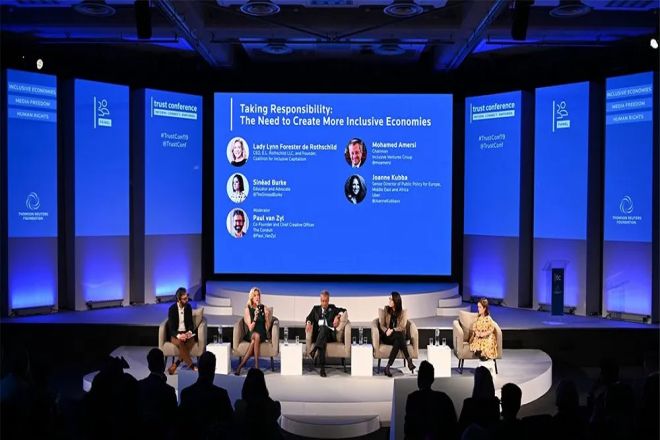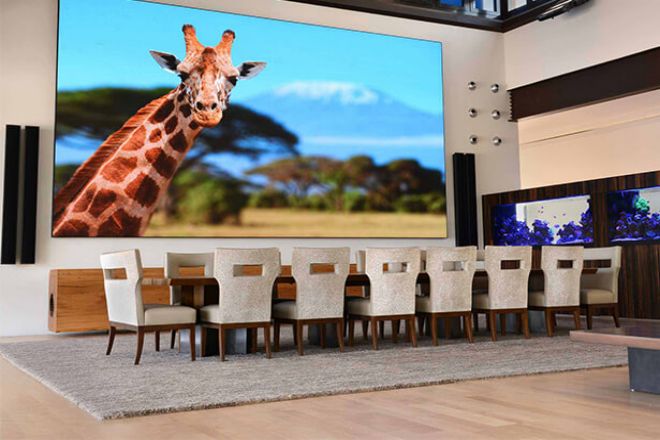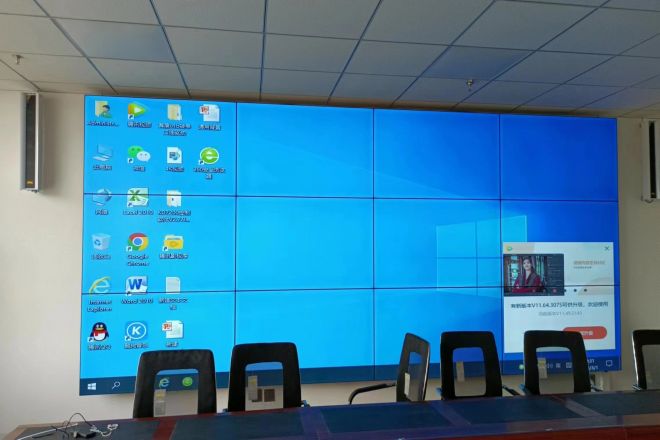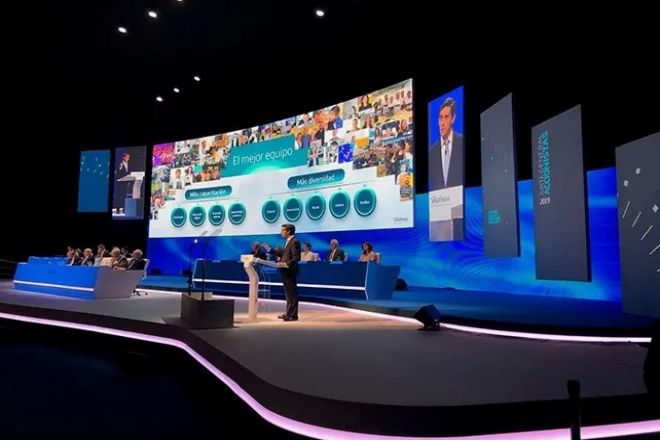مقدمة

From large outdoor billboards to sophisticated indoor monitoring centers, from stunning stage backgrounds to efficient corporate conference rooms, displays are changing our work and life everywhere.
من بين العديد من تقنيات العرض، شاشات LED ذات الملعب الصغير and LCD splicing screens have become the focus of attention in the market with their unique advantages.
With its ultra-high pixel density, excellent picture quality, and flexible installation methods, small-pitch LED displays have gradually occupied a place in the high-end display field. LCD splicing screens continue to maintain strong market competitiveness with their mature technology, stable performance, and wide application base
1. Overview of small-pitch LED displays

As the name suggests, small-pitch LED display screens refer to LED display screens whose pixel pitch is greatly reduced to a very small range. Specifically, the pixel pitch of this type of display screen is usually between 1 mm and 3 mm and can even reach smaller values, such as P0.9, P0.6, etc. This feature enables small-pitch LED displays to show unprecedented high pixel density, thereby achieving ultra-high-definition picture quality.
At the same time, high brightness and high contrast are also remarkable features, ensuring that even in a strong light environment, the picture can still be clearly seen, with rich colors and distinct layers.
1) تحليل المزايا
- High pixel density and ultra-high-definition picture quality:
Due to the significant reduction in pixel pitch, small-pitch LED display screens can present finer image details, whether it is text, pictures, or videos, they can reach or even exceed the limit of human eye recognition, bringing more realistic picture effects.
- Bright colors and high contrast:
With advanced LED light-emitting technology and fine color calibration, small-pitch LED display screens can show a wider color gamut and more vivid colors while maintaining high contrast, making the picture more vivid and three-dimensional.
- زاوية عرض واسعة:
Thanks to its unique display structure and material selection, small-pitch LED display screens can provide a wide viewing angle in both horizontal and vertical directions, ensuring that viewers can enjoy consistent visual effects no matter where they are.
- توفير الطاقة وحماية البيئة:
Although high pixel density may bring certain energy consumption challenges, modern small-pitch LED display screens fully consider energy-saving factors in design, using low-power LED chips and intelligent power management systems to effectively reduce overall energy consumption.
At the same time, its materials also meet environmental protection requirements and are conducive to sustainable development.
- مرونة قوية:
Small-pitch LED displays have strong splicing capabilities and can be flexibly combined into large displays of various shapes and sizes according to actual needs. This flexibility makes it very suitable for a variety of complex and changeable application scenarios.
2) تحليل العيوب
- Light transmission problem:
Although high pixel density brings excellent picture quality, it also increases the risk of scattering and reflection when external light is transmitted. This may affect the display effect, especially in outdoor or indoor environments with strong light.
- High energy consumption (some cases):
Although modern small-pitch LED displays have improved in energy saving, their high pixel density still requires more light sources and current drive compared to traditional display technology, so higher energy consumption may be generated in some cases.
- High price and high maintenance cost:
Due to technical and manufacturing cost limitations, the price of small-pitch LED displays is usually high. At the same time, due to its complex structure and sophisticated components, the maintenance cost is also relatively high. This may limit its popularity in some application scenarios with limited budgets.
- Poor plasticity:
Although small-pitch LED displays have splicing capabilities, their modular structure limits the ability of personalized customization and deformation design to a certain extent. This may limit its performance in some special application scenarios.
2. Overview of LCD splicing screen

The LCD splicing screen, as the name implies, is a large display screen made up of multiple LCD (liquid crystal display) units. It uses advanced liquid crystal display technology to achieve a clear display of images by precisely controlling the degree of light penetration.
This technology not only ensures the richness and accuracy of image colors but also gives the LCD splicing screen a wide range of options in terms of size, seam type, resolution, and brightness. Users can choose the appropriate size and configuration according to actual needs to meet the display needs of different occasions.
1) تحليل المزايا
High resolution and color performance:
LCD splicing screens have excellent resolution and color performance capabilities and can present more delicate and realistic images and videos. Its color reproduction is high and the color transition is natural, bringing a more realistic visual experience to the audience.
- زاوية عرض واسعة:
LCD splicing screens usually have a wide viewing angle, which means that viewers can get the same display effect in different directions. This feature makes LCD splicing screens perform well in occasions such as conference rooms and exhibitions where multiple people need to watch at the same time.
- توحيد السطوع:
Through advanced backlight control technology and optimized screen design, LCD splicing screens can achieve uniform brightness distribution and avoid the problem of local brightness being too high or too low. This helps to improve the overall display effect and reduce visual fatigue.
- Energy saving, environmental protection, and low maintenance cost:
Compared with other types of display screens, LCD splicing screens perform better in terms of energy consumption. Its low power consumption characteristics help to reduce operating costs while meeting modern energy-saving and environmental protection requirements. In addition, the maintenance cost of LCD splicing screens is relatively low because its structure is relatively simple and easy to repair and replace parts.
2). Disadvantage analysis
- Seam problem:
Although LCD splicing screens perform well in many aspects, the seam problem has always been the focus of users. After multiple LCD units are spliced, certain black edges or dark lines will be formed at the splicing, which affects the overall display effect to a certain extent. The seam problem may be more obvious when displaying large-format images or videos.
- Restrictions on use conditions:
Since LCD splicing screens use liquid crystal display technology, their working environment is subject to certain restrictions. Generally, LCD splicing screens are only suitable for indoor dry environments, and adverse factors such as direct sunlight and high temperature and humidity need to be avoided.
Therefore, when used outdoors or in harsh environments, you may need to take additional protective measures or choose another type of display screen.
3. Comparative analysis of small-pitch LED display and LCD splicing screen
1) تأثير العرض
وضوح:
Small-pitch LED display achieves high resolution with its extremely small pixel pitch (such as P2.0, P1.8, P1.5, P0.9, etc.), and the image display is more delicate and clear. In contrast, although LCD splicing screen also has a high resolution, it is limited by the existence of splicing seams and the overall clarity may be affected to a certain extent.
- استنساخ اللون:
Small-pitch LED display screens display rich and accurate images by precisely controlling the brightness and color of red, green, and blue LED lamp beads in each pixel. LCD splicing screens also have good color reproduction capabilities, but color shift or attenuation may occur under long-term use or high brightness.
- مقابلة:
Small-pitch LED display screens have high contrast, which can provide deeper blacks and brighter whites, making the color performance more vivid and vivid. The contrast of LCD splicing screens is also high, but it may be affected by factors such as backlight distribution and screen materials, resulting in differences in contrast in different areas or angles.
2). Brightness and energy consumption
- سطوع:
Small-pitch LED display screens have high brightness and can maintain clear display effects even in bright environments. At the same time, its brightness is highly adjustable, and it can automatically adjust the brightness according to the changes in ambient light to save energy.
The brightness of the LCD splicing screen is also adjustable, but it is limited by the brightness range and distribution uniformity of the backlight source, and may not reach the high brightness level of the small-pitch LED display.
- استهلاك الطاقة:
Although the small-pitch LED display has an advantage in brightness, its energy consumption is also relatively high. However, with the continuous advancement of LED technology and the improvement of energy efficiency standards, the energy consumption problem of small-pitch LED displays is gradually being solved.
LCD splicing screens are relatively low in energy consumption, especially LCD splicing screens with low-power backlight sources, which perform better in energy saving.
3). Resolution and splicing capabilities
- دقة عالية:
Small-pitch LED displays are known for their high resolution, which can provide more delicate and realistic images and videos. This high-resolution feature gives small-pitch LED displays broad application prospects in the field of high-end displays.
- Flexible splicing capabilities:
Small-pitch LED displays adopt a modular design and can be flexibly spliced into display screens of various sizes and shapes to meet the display needs of different occasions.
In contrast, LCD splicing screens may be limited by the border width and splicing technology during splicing, which may affect the display effect after splicing, especially when the black edge problem at the splicing seam is more prominent.
4). Applicable scenarios and costs
- السيناريوهات القابلة للتطبيق:
Small-pitch LED display screens are widely used in commercial displays, conference rooms, monitoring centers, and other occasions due to their excellent display effects and flexible splicing capabilities. Its seamless splicing and high-definition display effects can enhance the audience’s visual experience and meet high-end display needs.
LCD splicing screens are more suitable for occasions that require large-area displays but are relatively limited in budget, such as outdoor billboards, large conference rooms, etc.
- يكلف:
In terms of cost, the price of small-pitch LED display screens is usually higher than that of LCD splicing screens. This is mainly due to the large investment in materials, processes, and technologies of small-pitch LED display screens.
However, with the continuous advancement of technology and the intensification of market competition, the price of small-pitch LED display screens is gradually decreasing, and its cost-effectiveness is also increasing.
Although the price of LCD splicing screens is relatively low, it may not be comparable to small-pitch LED display screens in terms of display effects and splicing capabilities. Therefore, when choosing, it is necessary to make comprehensive considerations based on specific needs and budgets.
4. How do you choose between these two models?

When choosing between a small-pitch LED display and an LCD splicing screen, it is necessary to comprehensively consider multiple factors such as specific application scenarios, display effects, cost budget, etc. The following is a selection recommendation after a detailed comparative analysis of the two:
1) تأثير العرض
1.1). Clarity and color reproduction:
Small-pitch LED display: It has a high pixel density and can display more delicate and clear images. Accurate color reproduction, bright colors, and high saturation.
LCD splicing screen: It also has a high resolution, but due to the existence of splicing seams, the overall clarity may be slightly inferior to that of a small-pitch LED display. The color reproduction ability is strong, but color shift may occur under long-term use or high brightness.
1.2). التباين:
Small-pitch LED display: High contrast, can present deeper black and brighter white, and the picture has a strong sense of layering.
LCD splicing screen: The contrast is also high, but it may be affected by the distribution of backlight and screen materials, resulting in differences in contrast in different areas or angles.
2). Brightness and energy consumption
2.1). Brightness:
Small-pitch LED display: High and adjustable brightness, suitable for use in bright environments, such as outdoor billboards, large event sites, etc.
LCD splicing screen: The brightness is also adjustable, but it may not reach the high brightness level of small-pitch LED display screens due to the brightness range and distribution uniformity of the backlight source.
2.2). Energy consumption:
Small-pitch LED display screen: Although the brightness is high, the overall energy consumption is relatively low, thanks to the low power consumption characteristics of LED technology.
LCD splicing screen: It also performs well in terms of energy consumption, especially LCD splicing screens with low-power backlight sources.
3). Resolution and splicing capability
3.1). High resolution:
Small-pitch LED display screen: High resolution, suitable for displaying high-definition content.
LCD splicing screen: The resolution is also high, but after splicing, it may be affected by the splicing seam, resulting in a decrease in overall resolution.
3.2). Splicing capability:
Small-pitch LED display screen: It adopts a modular design, which is flexible and convenient to splice, and can achieve seamless or micro-seam splicing to enhance the overall visual effect.
LCD splicing screen: There may be a wider border (splice seam) when splicing, which affects the overall aesthetics and visual effect.
4). Applicable scenarios and costs
4.1). Applicable scenarios:
Small-pitch LED display screen: It is more suitable for occasions with extremely high requirements for display effects, such as commercial displays, high-end conference rooms, stage backgrounds, etc.
LCD splicing screen: suitable for occasions that require large-area display but have relatively limited budgets, such as monitoring centers, conference rooms, etc.
4.2). Cost:
Small-pitch LED display screen: The price is relatively high, but with the advancement of technology and the intensification of market competition, the price has gradually become reasonable.
LCD splicing screen: The price is relatively affordable and suitable for users with limited budgets.
5). Selection suggestions
5.1). Choose according to the application scenario:
If you need to use it in a bright environment or pursue the ultimate display effect (such as high-definition picture quality, high contrast, seamless splicing, etc.), it is recommended to choose a small-pitch LED display screen.
If the budget is limited and the display effect requirements are not particularly high (such as general conference rooms, monitoring centers, etc.), you can choose an LCD splicing screen.
5.2). Careful consideration of cost and performance:
When choosing, in addition to considering the display effect, you also need to consider factors such as cost budget, the difficulty of installation and maintenance, and the possibility of later upgrades.
5.3). Consult professionals:
If you don’t know much about the two products or find it difficult to make a choice, it is recommended to consult a professional display equipment supplier or technician to get more accurate advice and help.
خاتمة
In summary, small-pitch LED display screens and LCD splicing screens have their own advantages, and they show unique charm and value in different application scenarios.
Small-pitch LED displays have become the leaders in the high-end display market with their ultra-high-definition picture quality, flexible splicing capabilities, and broad application prospects, while LCD splicing screens continue to meet the needs of a large number of mid- and low-end markets with their mature technology, stable performance, and low cost.
When choosing display products, we should make comprehensive considerations based on actual application scenarios, budget constraints, and performance requirements. Whether pursuing the ultimate visual effect or focusing on the balance of cost-effectiveness, you can find a solution suitable for yourself using these two technologies.
أخيرًا، إذا كنت تريد معرفة المزيد عن شاشات LED، يرجى الحصول على اتصال معنا.
